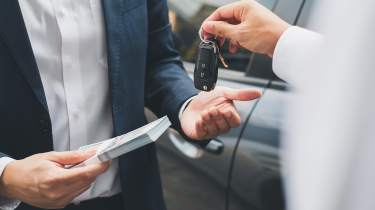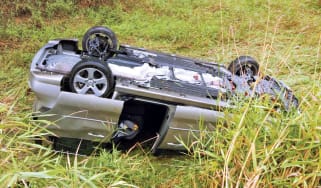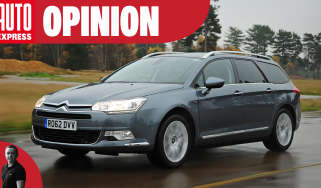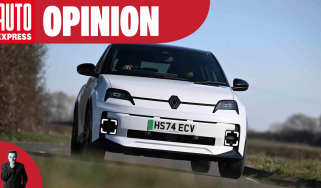How to test drive a car
Our tips and tricks on how to take a test drive in a new or used car

After a house, a car is likely to be the second most expensive purchase you’ll make, and you’ll typically have to live with your buying decision for quite a while.
That’s why test driving a prospective purchase is so important; in the case of a new model it’s your chance to make sure a car fits in with your needs and that you’re happy with what you’re getting for your money. If you’re buying second-hand, test driving a car is your best – and often only – chance of making sure it drives as it should, before paying for it.
At Auto Express, we test drive new cars every week in order to provide the verdicts buyers can rely on, so you could say it’s our bread and butter. But while we aim to produce reviews covering the broadest range of factors, and in the most objective manner possible, we can’t reflect every driver’s subjective tastes and preferences – which is where you, and your test drive, come in.
By the same token, we don’t expect everyone to be confident about taking a test drive, or even to really be sure about what they should be looking out for. Even if you are well clued up, some of our personal experiences when shopping for our own wheels suggest that excitement and enthusiasm can lead to rash decisions that you may regret in hindsight.
As always, preparation is key, and in the case of a test drive that means taking care to make sure you’re asking the questions you need answers to. It could be you rehearse a set of mental ‘tick boxes’ to keep you focused, but there’s also a lot to be said for making notes in advance that you can refer to during the drive.
Test drives and insurance
Driving on UK roads without insurance is illegal, so make sure you’re insured before so much as putting the car into gear. This is rarely an issue if you’re buying a new car, or if you're testing a used car from a dealership. Dealers have insurance that will cover you for a test drive – you should ask them about this before driving on the road. It's mainly an issue when buying a car privately.
Dealers may want to see your licence before letting you take a test drive, but it's usually no trouble at all and they will have people test driving cars all the time. It's still your responsibility to check that you are insured, though. This goes for private sales as well – check that your insurance on your own car covers you, and confirm with the owner by showing them your certificate.
You should contact your insurer to double check that you are insured – not all insurance policies cover you on other cars, and in fact it's not as common as you might think. You can also take out temporary insurance to cover you for a few hours, and it’s usually not that expensive – £15-20 is typical for a few hours’ coverage. Check with the seller that they’re happy for you to drive the car with this kind of insurance.
Only drive the car if both you and the seller are happy with the insurance arrangements and if you’re happy that the car is safe and roadworthy. If in any doubt, don’t take the risk.
Test drive insurance top tips
- Don’t drive any car unless you’re 100 per cent sure you’re insured to do so.
- Large dealerships will usually cover you to drive their demonstrators, but at smaller garages you may need to get your own insurance cover. Ask first.
- Understand the terms of the insurance before driving; it may only offer third-party cover.
- Take your driving licence with you when you go to take a test drive.
How to take a test drive
Once the insurance is sorted you can get to the good bit: the test drive itself. Don’t get carried away though; while it’s exciting being handed the keys to the car you’ve had your eye on for days, weeks, or months, you need to remain level-headed and inspect the car with a critical eye, as anything you miss on the test drive could come back to haunt you later.
During the test drive think about how the car suits your needs and don’t let the salesperson sitting next to you sway your judgement.

It might be a good idea to bring a friend or family member who can sit in the car with you, hold a list of questions you have about the car and prompt you. How is the driving position? Can you see out easily? Is the engine noisy? If you’re buying used, check out our buying guide for the model in question and write a list of questions before you head out.
How long is a test drive?
Most test drives should take around 15 to 30 minutes, but it’s important to take your time to get as much information as possible about the car during the drive. Don’t worry if you need more time to make your mind up about the car – you’re the customer and a test drive can be as long as you need it to be (within reason).
Ideally you’ll want to test the car on as many types of roads as you’re likely to experience in your usual driving mix. You’re unlikely to tick-off everything, from motorways to city centres to country roads, especially if the dealership has a predetermined test drive route in their local area, but you want to at least experience the car at a range of different speeds and on clear roads as well as in traffic.
Don’t be afraid to ask the salesperson if you want to take the car for more than just a spin around the block – if you’re about to potentially spend thousands on the car, they’re likely to be at least somewhat accommodating.
Some franchised dealerships even run extended test drive offers from time-to-time where you can have the car for 24 or 48 hours to get better acquainted. Even 7-day test drives are not unheard of and will give you a chance to experience the car without the distraction of a salesperson.
If you make clear to a salesperson that you’re seriously considering buying the car in question, you’ll get a lot more out of the dealership’s staff amid other customers who may take test drives with no intention of buying anything at all. Show that you’ve done your research, have taken test drives elsewhere and are nearing a decision on a new car and they’ll feel that you’re a genuine buyer worthy of their attention.
By the same token, though, remember that you’re under absolutely no obligation to buy any car after taking a test drive. If it’s not right for you, just walk away.
Test drive length top tips
- Your test drive is most likely to be between 15 and 30 minutes but don’t be afraid to ask for longer if you feel you need it.
- Some dealers offer special extended test drives of 24 or 48 hours from time to time. Even 7-day test drives are not unheard of.
- Make the most of the time you have in the car to form your opinions and gather information.
Before you drive the car
First things first, you need to be sure exactly which car it is you’re driving. If you’re at a main dealer buying a new car, there’s a very good chance that the demonstrator won’t be the exact specification of the car that you intend to buy. Find out exactly which engine and trim level the car you’re driving is, if any options are fitted and what it costs. Then compare this to the model you’re thinking of buying because it’s likely that the top-spec demonstrator will show the model in a better light than the version you can afford.
You’ll probably have already had a good poke around the car before taking a test drive but you should continue to evaluate questions around its size, how comfortable you feel in it and how easy it is to use before you get out on the road and worry about how it drives.
Your car needs to be big enough to comfortably carry all the things and people you need it to. If you regularly carry bulky cargo like a pushchair or golf clubs, take it along and see how it fits in the boot.
Spend some time adjusting the seat as you’d like it, checking that you’re comfortable and that there’s enough legroom left in the seat behind, before you set off on the test drive. Adjust the mirrors and check to make sure you’ve got a good view to the front and the rear of the car – and use this time to evaluate not just whether you’re ready for the test drive, but whether the seat, visibility, and layout of the controls is actually something you’re happy with.
Familiarise yourself with the important controls – lights, indicators, gearbox but also check how easy the minor controls are to locate and use. It’s a good idea to try pairing your phone with the car to see how that works, if you regularly do this in your own vehicle. You need to make allowances here because you’ll be unfamiliar with the car but clear menus, logically placed buttons and easy-to-read graphics are all obvious plus points.
Test drive preparation top tips
- Make sure you do your research and find out exactly which car you’ll be driving before getting behind the wheel.
- Understand any differences between the car you’re driving and the one you’re thinking about driving.
- Take any bulky items you regularly carry in your car to see how they fit in the new one.
- Familiarise yourself with all the controls and try pairing your phone with the car before setting off.
- Take time to set the seat, steering wheel and mirrors as you like them.
Test driving a new car
If you’re buying a new, or even nearly new, car from a main dealer there should be no worries about faults or the condition of the car. Naturally, you should have a quick scan around to make sure it’s generally in good condition, but otherwise you can get straight onto the driving experience.
Once again, you need to make some allowances. Recognise the fact that this is a car you haven’t driven before and it will take some getting used to but you can certainly evaluate all the key aspects of what it’s like on the road.
Secondly, be aware that you’re unlikely to be able to form a sound judgement on how a car drives compared to the other models you’re considering after taking them all on short test drives. Hopefully, you’ll read Auto Express reviews for that kind of in-depth insight. The test drive is more about whether you like the way it drives, which options you want to choose and how you feel about the car overall – that’s the most important thing after all.
Think about the steering. Is it light enough for you to turn easily at low speeds and does it have enough weight to make you feel confident when positioning the car on faster roads? If there’s a manual gearbox, does it shift smoothly and how does the clutch feel? If the car is an automatic, does it shift promptly on your throttle inputs and can you comfortably reach the steering wheel paddle shifters? If it’s electric, are you happy with the feel of the accelerator, and how the car responds when you lift off again, or use the brakes? If the car has variable levels of regenerative braking, try adjusting it to see how the car behaves.
The car’s suspension is also crucial. Is the ride as smooth as you’d expect on the kind of roads you’re driving along? How well does it cope with potholes, large undulations and sharp changes in direction? If the ride isn’t as comfortable as you’d like, remember that opting for smaller wheels or a model with different suspension settings can make a huge difference.
As far as the engine goes, you should be considering whether it’s strong enough for you. Remember that performance will take a tumble if you regularly carry four people (or more, in a large SUV or MPV) and loads of luggage and this can mean working the engine harder to maintain progress.
You might feel a little reluctant to do so under the watchful eyes of the salesperson but remember to rev the engine to the top of its rev range to see what it sounds like and, if the route allows, check engine, wind and tyre noise at motorway speeds – you want to be comfortable on long trips.
The clutch in manual cars and brakes in a car you’re not familiar with can take a little bit of getting used to so make allowances for this. Try to do a reverse park or some other manoeuvre to check that you’re comfortable with the car’s size and your view out, and to see how effective the parking sensors and cameras are, since you’ll be using these on a regular basis if you buy the car.
Test driving a used car
Test driving a used car is a far more complex process than test driving a used one, mainly because you’re looking for potential issues with the pre-owned vehicle as well as working out whether you like it or not. Our used car checklist gives more thorough advice to used car buyers but we’ll deal with the basics of the test drive here.
If you’re buying from a main dealer, the used car will have gone through a comprehensive pre-sale inspection so its basic condition should be good, for the mileage and price. You should still give it a comprehensive inspection of your own looking for damaged bodywork or wheels outside and scuffed trim or bad smells inside, such discoveries can help you negotiate the price down.

Check the mileage showing on the odometer and ask yourself if the condition of the car tallies with the displayed mileage. If you have any doubts, you can check the mileage of the car at its MOT history on the UK government website. This will give a better idea of whether anything is amiss.
Check to see whether the car is warm when you start it as dealers often warm-up older cars that have trouble cold-starting before customers come to take a drive. Pop the bonnet open and hold your hand close to the engine (but avoid actually touching any areas that might be very hot if it’s been running) – and if the engine is warm, ask about it. Their response will tell you how trustworthy they are – a denial is a sign that they aren't telling you the whole truth and should be avoided.
Press all the buttons and flick all the switches to make sure that everything works as intended. Once you turn the car on, keep a close eye out for any dashboard warning lights that might flag a malfunction. In most cases, any defects will be covered by the warranty but it’s far better to get them sorted out before you buy.
On the road, pay particular attention to the way the clutch and brakes feel. Look for smooth pedal travel and progressive stopping power from the brakes and a clear biting point from the clutch.
The engine should accelerate smoothly with no unexpected or undue noise and not too much exhaust output. Manual gearboxes too, can begin to feel tired after extensive use so check how easily the car slots into every gear – including reverse. The steering should turn the car smartly when you begin to move the wheel and any unusual clunks or squeaks from the suspension should definitely be investigated before you part with any cash.
Keep an ear out for any kind of rattles or hums emanating from the cabin and ask the dealer to investigate if you’re not happy. Indeed, the salesperson is there to help so ask as many questions as you can to clear up any uncertainty. The same considerations around whether you feel comfortable in the car apply with used vehicles just as they do with new ones.
Top tips for test driving a car
- If possible, test the car on a range of different road types and in various traffic conditions.
- Paying particular attention to how the car feels in the type of driving you do most of.
- Check the ride comfort on poor road surfaces and the noise levels on faster roads.
- Think about how comfortable you feel in the car, how easy the controls are to reach and how well you can see out.
- Be aware of awkward controls but remember that these things can improve with familiarity.
After the test drive
If you’re going to be testing a few cars, it’s a good idea to make a few notes of your initial impressions straight after the test drive, which should help you compare and contrast between different cars, or different examples of the same car. And also make a note of anything you’d like the dealer to address.
At this point the salesperson will be looking to close the deal on the car but it’s very important that you ignore any pressure to buy. A test drive is just that and you shouldn’t feel obliged to take things any further, unless you really want to. Give yourself a little cooling off period. A seller will usually be more than happy for you to take some time to think about the car, what you like and what you don’t, in your own time, then come back and do the deal when you’re ready, or don’t.
The test drive can be an enjoyable experience but the real enjoyment comes from making the right decision on a great new car that you’ll love owning. The test drive is just an important part of the process towards that goal so it always pays to get it right.
Our dealer network has 1,000s of great value new cars in stock and available now right across the UK. Find your new car…
Find a car with the experts













